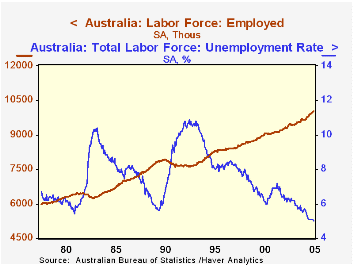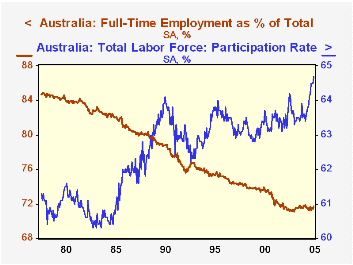 Global| Jul 07 2005
Global| Jul 07 2005Australia Unemployment Falls; Employment Passes 10 Million
Summary
Australian labor markets are showing marked strength, according to labor force data reported today by the Australian Bureau of Statistics. The unemployment rate fell to 5.0%, the lowest reading since monthly surveys began in February [...]

Australian labor markets are showing marked strength, according to labor force data reported today by the Australian Bureau of Statistics. The unemployment rate fell to 5.0%, the lowest reading since monthly surveys began in February 1978. This result was unexpected, as forecasters had projected an uptick to 5.2%.
Accompanying employment data also reached a benchmark, with a 41,700 increase in the number employed to 10.023 million, the first tally surpassing 10 million. This is 3.8% larger than the year-ago figure. Further, the number of full-time employees rose more, by 60,200, while part-timers decreased 18,600. This development brought the proportion of full-time workers to 71.7% of total employment. For the first 25 years of this survey, that proportion trended consistently lower, but since the middle of 2003, the share has stabilized and tilted slightly upward, suggesting that employers have some confidence that their demand for workers will be sustained.
The month's results also extended a steep gain in labor force participation. The rate was 64.7% of the working-age population (15 years of age and older), a record high and up more than a full percentage point just since last August.
Analysts pointed out in press reports today that Australia is benefiting from increased sales to China and from a surge in commodity prices. Indeed, today's Wall Street Journal has an entire feature on traffic jams in Queensland ports as ships wait to load coal for export. Just a week ago, the Bureau of Statistics reported a gain in local retail sales after two monthly declines, leading some to conclude that the employment growth is beginning to prompt higher spending.
| Australia Seasonally Adjusted |
June 2005 | May 2005 | June 2004 | 2004 | 2003 | 2002 |
|---|---|---|---|---|---|---|
| Employed (thous) | 10023 | 9981 | 9656 | 9682 | 9481 | 9270 |
| Change (thous/%) | +42 | +14 | 3.8 | 2.1 | 2.3 | 2.0 |
| Unemployed (thous) | 528 | 540 | 576 | 566 | 611 | 636 |
| Unemployment Rate (%) | 5.0 | 5.1 | 5.6 | 5.5 | 6.0 | 6.4 |
| Participation Rate (%) | 64.7 | 64.5 | 63.6 | 63.6 | 63.6 | 63.4 |
Carol Stone, CBE
AuthorMore in Author Profile »Carol Stone, CBE came to Haver Analytics in 2003 following more than 35 years as a financial market economist at major Wall Street financial institutions, most especially Merrill Lynch and Nomura Securities. She had broad experience in analysis and forecasting of flow-of-funds accounts, the federal budget and Federal Reserve operations. At Nomura Securities, among other duties, she developed various indicator forecasting tools and edited a daily global publication produced in London and New York for readers in Tokyo. At Haver Analytics, Carol was a member of the Research Department, aiding database managers with research and documentation efforts, as well as posting commentary on select economic reports. In addition, she conducted Ways-of-the-World, a blog on economic issues for an Episcopal-Church-affiliated website, The Geranium Farm. During her career, Carol served as an officer of the Money Marketeers and the Downtown Economists Club. She had a PhD from NYU's Stern School of Business. She lived in Brooklyn, New York, and had a weekend home on Long Island.





